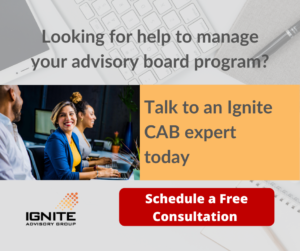As CAB managers maintain the momentum of the customer advisory board (CAB) programs, one of the key checkpoints on initiative status will be their internal stakeholder meetings. After all, such stakeholders are key to ensuring program success and confirming CAB managers have the requisite “air cover” to mandate everyone is doing their part. Such meetings provide an opportunity to give program updates, and gather approvals on forward-looking plans.
In participating in and supporting such stakeholder meetings for over a decades, we have seen some CAB practitioners manage these very well, and, unfortunately, others who don’t and allow them go sideways—or even completely out of control.
As such, here are five must-dos when managing your CAB program internal stakeholder meetings:
1. Hold regular internal stakeholder meetings
From the initiation of your CAB program, it’s important for CAB customer advisory board managers to schedule regular meetings with your executive sponsor and entire stakeholder team. In them, you can review program progress and status, show upcoming plans and timelines, and gather any necessary approvals. As such, these meetings should take place monthly or even bi-weekly for an hour – you need the time to “go deep” to generate discussions, gather consensus and get clear direction. (This meeting should be separate from your CAB management team, which focuses on logistics and tactics, and can take place weekly for 30-60 minutes.)
2. Come prepared
When holding your CAB stakeholder meeting, always plan to be putting something in front of your stakeholders to review or react. While it’s OK to brainstorm “out of the box” ideas for, say, upcoming meeting topics, you should have plenty of those already at hand from your last meeting “treasure box” (topics that came up that you were not able to fully address) or previous member survey results which no doubt include many desired topics to consider. Coming to a stakeholder meeting empty handed can lead to anarchy, or a waste of time for participants – who will remember this come time for your next CAB stakeholder meeting.
3. Ensure tasks are progressing
If meeting preparation tasks or action item progress are falling behind, the stakeholder meeting is the place to bring these up, as your executive sponsor should have the “clout” to ensure things get back on track (where CAB managers may not have quite the same influence necessary). It’s not about throwing anyone under the bus; CAB managers should be honest and transparent about their program status and bottlenecks, the potential ramifications of any issues, and suggested remedies to improve – that your stakeholders will likely recognize and adopt.
4. Focus on strategy
You need your CAB customer advisory board internal stakeholders to provide and approve strategic direction into the content of your next CAB meeting – what high-level programs do you want to preview with members?, what What input of theirs do you need and what fork in the road questions do you want answered? What’s coming in the next 12 months? What products are you launching or new markets are you are entering? What budget constraints are you weighing? What environmental forces are impacting your customers and industry? CAB managers should bring their knowledge of such subjects to the stakeholder meeting for review – these are the strategic discussion topics which should be addressed in stakeholder meetings in order to discover their role and potential impact on your CAB members.
5. Avoid tactical minutia
What CAB managers DON’T need to discuss or put front and center with their stakeholders are tactical meeting minutia – meal and wine selections, social activity details, tchotchke member gifts, polling question wording, length of meeting breaks, etc. While you can communicate these items to your stakeholders as a meeting approaches, you should only do so AFTER all strategic items are finalized, and not make tactical items into long discussions that will drain valuable executive face time. While I understand that many company managements will want to approve such plans, they should also have the trust in their CAB management team and event planners to handle all the minor details. I personally have witnessed too many long discussions with internal executive stakeholders on such trivial items that have distracted from needed strategic decisions. Don’t let this happen to you!
If managed correctly, CAB internal stakeholder meetings can ensure your program is strategically focused and on-track for success. Managed incorrectly, and your stakeholders will “help” you on tactical items to which you didn’t need any guidance, and your program will suffer – and your members will notice.
Ignite Advisory Group is the leading global authority on Customer Advisory Boards and Customer-Led Boards. Ignite’s proven methodology for managing and evolving Customer Advisory Boards includes a 4-stage process, encompassing 48 deliverables and measured by 20 metrics to deliver a clear ROI. To learn more about Ignite, visit our website, read our blogs, and follow us on LinkedIn. To find out how your company can benefit from Ignite’s CAB methodology and process, contact us today.

